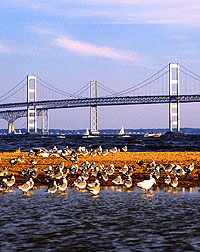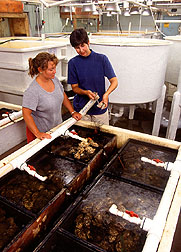This page has been archived and is being provided for reference purposes only. The page is no longer being updated, and therefore, links on the page may be invalid.
|
|
Chesapeake Bay Day: Coordinating Research to Improve Farm Practices, Bay Health
By Don Comis
October 5, 2005
WASHINGTON, Oct. 5—U.S. Department of Agriculture officials signed an agreement in Maryland today to enhance research coordination to improve the health of the Chesapeake Bay, the largest estuary in the United States.
USDA officials signed a Memorandum of Understanding (MOU) with the U.S. Environmental Protection Agency (EPA) Chesapeake Bay Program Office and the Mid-Atlantic Regional Water Quality Program, which includes Bay-area state universities.
The signing was held at the Henry A. Wallace Beltsville (Md.) Agricultural Research Center, operated by the Agricultural Research Service, USDA's chief in-house scientific research agency.
"The purpose of this agreement is to strengthen cooperation in a collaborative effort to fulfill the commitments of the Chesapeake 2000 agreement of the Chesapeake Bay Program, especially the 'Keystone Commitments,'" said Merle Pierson, USDA Deputy Under Secretary for Research, Education and Economics.
|
|
At the event—designed to show research solutions that can reduce bay pollution from farms—Maryland Agriculture Secretary Lewis R. Riley spoke about the role of farmers in the bay cleanup.
One of the many displays on exhibit described another boost to bay research: selection of the Choptank River watershed as one of 12 ARS research watersheds chosen nationally for the new USDA Conservation Effects Assessment Program (CEAP).
"Both the EPA agreement and the CEAP project reflect an intensifying collaborative effort to build on the bay research that BARC and the universities have engaged in for about two decades now, working with EPA and the U.S. Geological Survey," said ARS Beltsville Area Director Phyllis Johnson.
Johnson announced plans that include research to process manure into fuel and safer fertilizers. Other plans announced included growing perennial grasses for fuels. These grasses are considered bay-friendly because they do not require annual planting, which can cause soil to erode into the bay. They also require less fertilizer, reducing the potential for nutrient pollution.
"We would also like to partner with other organizations to start a genetics program for aquatic vegetation to help meet the goal of having 185,000 acres of submerged aquatic vegetation in the Chesapeake," Johnson said. "We are discussing this with the University of Maryland at College Park and the Eastern Shore, as well as the University of Maryland Center for Environmental Science at Horn Point."
Tours and exhibits at BARC displayed the bay-related work of many of the center's 320 ARS researchers.


